Ruth Ellen Gruber's Blog, page 19
June 17, 2011
Poland -- More on the night of the synagogues and Krakow
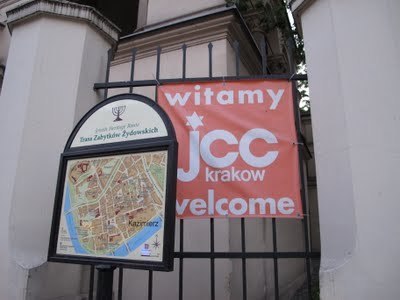 Sign for the Krakow JCC and a tourist map of Jewish sights in Kazimierz. Photo (c) Ruth Ellen Gruber
Sign for the Krakow JCC and a tourist map of Jewish sights in Kazimierz. Photo (c) Ruth Ellen GruberI wrote my latest Ruthless Cosmopolitan column on the revival of Jewish spirit in Krakow, following my participation in the Night of the Synagogues -- and a conversation I had with Jonathan Ornstein, the director of the Krakow JCC, the morning after.....We both needed caffeine..... I posted about the Night of the Synagogues last week on my this blog -- with lots of pictures.
By Ruth Ellen Gruber
June 15, 2011
KRAKOW, Poland (JTA) -- Jews in Krakow have a new slogan -- "Never Better."
The catchphrase is deliberately provocative, a blatant rejoinder to "Never Again," the slogan long associated with Holocaust memory and the fight against anti-Semitic prejudice.
It may be counterintuitive, acknowledges Jonathan Ornstein, the American-born director of Krakow's Jewish community center who helped come up with the slogan.
But it's aimed at rebranding Jewish Poland, or at least Jewish Krakow, shaking up conventional perceptions and radically shifting the focus of how the Jewish experience here is viewed.
"Because the Holocaust isn't subtle, then the rebranding, as a way to get people to understand the situation here now, also can't be subtle," Ornstein explained.
Only a few hundred Jews live in Krakow, but the community has been rebuilding in the past two decades, particularly since the JCC opened three years ago.
"When we say 'Never Better,' it's not in terms of numbers, or the amount of things in Jewish life, or the synagogues that are functioning and all that," Ornstein said.
However, he went on, "in terms of the way the Jewish community interacts with the non-Jewish community and the direction that things are going, I think that there's never been a more optimistic time to be Jewish in Krakow than there is now."
I spoke with Ornstein on a Sunday in June, the morning after an unprecedented event that in a way had been a public affirmation of the new Jewish spirit he described.
Organized by the JCC, the American Jewish Joint Distribution Committee and the Krakow Jewish communal organization, it was called 7@Night -- Seven at Night or the Night of the Synagogues.
Night of the Living synagogues may have been a better description.
From 10:30 p.m. until 2 a.m., all seven of the historic synagogues in Krakow's old Jewish quarter, Kazimierz, were open to the public.
It was part festival, part celebration and part didactic exercise. The aim was to foster Jewish pride, but also to educate non-Jewish Poles about contemporary Jewish life and culture.
An astonishing 5,000 or more people turned out, a constant flow of people that trooped from one synagogue to the next and patiently braved long, slow lines and bottlenecks at doorways. Almost all were young Cracovians.
Each synagogue hosted an exhibit, concert, talk or other activity that was produced by Jews and highlighted Jewish life and culture as lived today in Poland, Israel and elsewhere.
Events ranged from talks by Krakow Rabbi Boaz Pash on "the ABCs of Judaism" to a live concert by an Israeli rock band to a DJ sampling new Jewish music from a console set up on the bimah of the gothic Old Synagogue, now a Jewish museum, to a panel discussion about the role of women in Judaism.
All the events were free -- and all were full.
"It far, far exceeded our expectations," said Ornstein.
I've never seen anything quite like it, even though I've followed the development of Kazimierz for more than 20 years -- from the time when it was an empty, rundown slum to its position now as one of the liveliest spots in the city.
I've witnessed -- and chronicled -- the development of Jewish-themed tourism, retail, entertainment and educational infrastructure in Krakow, including the Jewish Culture Festival that draws thousands of people each summer. And I've written extensively about the interest of non-Jews in Jewish culture.
But Seven at Night was something different. For one thing, nostalgia seemed to play no role. And also, unlike many of the Jewish events and attractions in Kazimierz, this one was organized and promoted by Jews themselves.
It was their show, kicking off with a public Havdalah ceremony celebrated by Rabbi Pash that saw hundreds of people singing and dancing in the JCC courtyard.
"Never Better" was a prominent theme.
Most explicitly, it was the title of a multimedia presentation that ran throughout the night, projected on the vaulted ceiling of the 16th century High Synagogue, which today is used as an exhibition hall. The presentation featured interviews with local Jews young and old, religious and secular, all expressing a confidence in their identity and future.
It's still anybody's guess whether or not demographic realities will enable the long-term survival of a Jewish community in Krakow. But Ornstein said that may not be the point.
A key message of the current activism, he said, was to help frame the context of Polish Jewish history and hammer home that however small their numbers, Jews in Poland are not a separate, exotic entity but part and parcel of 21st century Polish society.
"The powerful message is that Judaism isn't just an idea, it's not just something that belongs to the Polish past, but there are Jews living here," Ornstein said. "We're trying to say that you can be a Jewish Pole, not just a Jew in Poland, to turn 'Jew' into an adjective instead of a noun."
I hope he's right.
Published on June 17, 2011 03:49
June 16, 2011
Poland -- Sanok. Gwozdziec synagogue project
 Laura Brown, co-director of Handshouse Studio, with replica of Gwozdziec synagogue. Photo (c) Ruth Ellen Gruber
Laura Brown, co-director of Handshouse Studio, with replica of Gwozdziec synagogue. Photo (c) Ruth Ellen GruberBy Ruth Ellen Gruber
Earlier this month I spent several days in Sanok, in the far southeastern corner of Poland, visiting the site of the Gwozdziec synagogue project -- the construction of a replica of the roof and decorated inner cupola of the destroyed wooden synagogue of Gwozdziec (now in Ukraine) -- one of about 200 wooden synagogues torched by the Nazis in World War II
The article I wrote about it for the International Herald Tribune/New York Time online is now readable -- click HERE to read the full story
The article gives pretty much of an overview of the project, run by the Massachusetts-based Handshouse Studio -- and if you want detailed descriptions of the process, Edward Levin, of the Timber Framers Guild, has been keeping a wonderful blog about it all, with lots of pictures and theoretical musings. Click HERE to read it.
In the far southeast corner of Poland, the warm summer air is resounding with the rasp of old-fashioned iron saws and the satisfying twack-twack-twack of ax blades on wood.
Here, in the foothills of the Carpathians, an international crew of master timber craftsmen and students has been working on an intensely hands-on project that combines history, art and education. They are building a replica of the tall peaked roof and inner cupola of an ornate wooden synagogue that stood for 300 years in the town of Gwozdziec, now in Ukraine.
The replica, which will be 85 percent of the original size of the building, will be installed as one of the key components of the Museum of the History of Polish Jews, currently under construction in Warsaw and scheduled to open in 2013.
My discussions in Sanok opened a new world to me -- that of Timber Framing and master carpentry; people involved who find spirituality in working with wood. Fascinating discussions.
Here are some of my own pictures of the project, which is being carried out on the grounds of the Sanok open-air folk architecture museum.
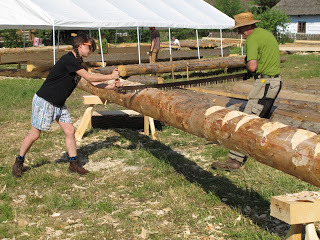
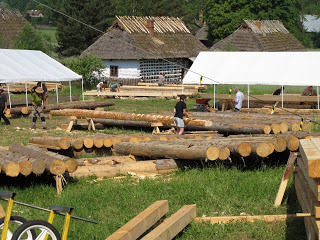
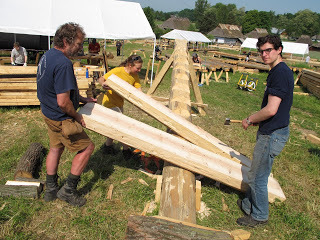
Published on June 16, 2011 02:28
Serbia -- Belgrade Jewish Museum downloadable guidebook
By Ruth Ellen Gruber
I just found a downloadable version (PDF) of the illustrated, 35-page guidebook to the Museum of Jewish History in Belgrade, published last year. Go to the link by clicking HERE. I will add it to the other PDF guides I have on my iPad....
I just found a downloadable version (PDF) of the illustrated, 35-page guidebook to the Museum of Jewish History in Belgrade, published last year. Go to the link by clicking HERE. I will add it to the other PDF guides I have on my iPad....
Published on June 16, 2011 01:34
June 15, 2011
Poland -- the Chassidic Route: Lesko
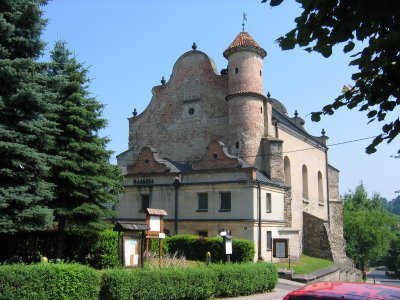 Former Synagogue in Lesko. Photo (c) Ruth Ellen Gruber
Former Synagogue in Lesko. Photo (c) Ruth Ellen GruberBy Ruth Ellen Gruber
The last time I had been in Lesko was in 2006, when I was updating my book Jewish Heritage Travel -- but also attending the annual biker and country music festival held there, "Moto Country Piknik." It was a wild night full of black leather-clad beer-drinkers, heavy metal chrome, and Polish country acts, most of whose names I didn't get.
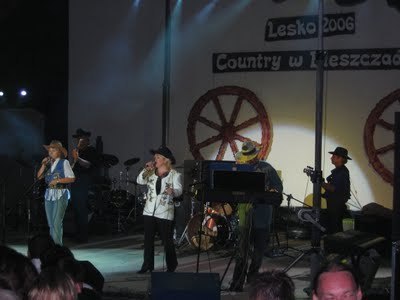 Lesko Moto Country festival, 2006. Photo (c) Ruth Ellen Gruber
Lesko Moto Country festival, 2006. Photo (c) Ruth Ellen GruberFive years later, on the Jewish heritage front, I found little changed...
The imposing synagogue, just off the main market square, dates from the mid 17th century. It is the only one of five prayer houses to survive World War II. It was devastated during the war and rebuilt in the 1960s -- the reconstruction added baroque gables (which a booklet on sale at the synagogue said had been removed in the 19th century). That on the front facade frames the depiction of the Ten Commandments. The reconstruction also extended the height of the tower so that it now extends above the roof level.
All in all, I find it a very beautiful and impressive building -- and, importantly, there has long been separate signpost outside identifying it as a former synagogue and describing the history: before World War II, nearly two-thirds of the town population was Jewish. In the entry hall there are several plaques listing the names of hundreds of Lesko Jews killed at the Belzec death camp in 1942.
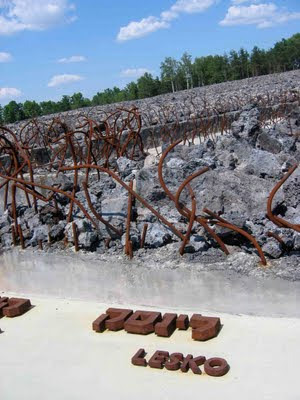 Memorial to Lesko Jews at Belzec. Photo (c) Ruth Ellen Gruber
Memorial to Lesko Jews at Belzec. Photo (c) Ruth Ellen GruberThe synagogue is now used as a gallery displaing and selling local arts and crafts. Five years ago I bought there a wonderful naive carving of the late Pope John Paul II, wearing red shoes and with his head surrounded by angels.
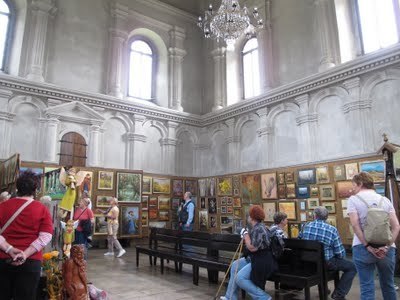 Inside the synagogue gallery. Photo (c) Ruth Ellen Gruber
Inside the synagogue gallery. Photo (c) Ruth Ellen GruberEach time I've visited the gallery, I've found a refreshing lack of kitschy carved Jewish figures and paintings on sale -- such as those so prevalent in Krakow and Warsaw... but one of the local artists still did utilize the "Jew and money" stereotype in a rather outrageous manner! That's real money clutched in their hands!
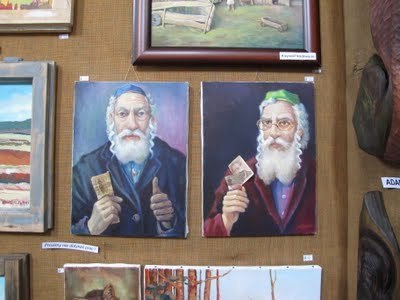 Photo (c) Ruth Ellen Gruber
Photo (c) Ruth Ellen GruberThe Jewish cemetery in Lesko, founded in the 16th century, is one of the oldest and most historically important in Poland. It is vast, and rises up a steep hill, just down the road from the synagogue. The oldest stones are at the bottom, by the entrance -- massive slabs with vividly carved epitaphs but no other decoration. Here is where the tour groups stop -- a Polish tour group was visiting this time when I entered.
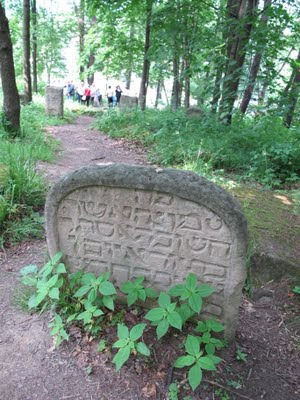 Photo (c) Ruth Ellen GruberFew people, however, venture and farther up the hill, except for school kids using one of the paths as a short cut.
Photo (c) Ruth Ellen GruberFew people, however, venture and farther up the hill, except for school kids using one of the paths as a short cut.The higher you go -- at least in early summer -- the more, and more recent, and more vividly carved stones there are. But also, the more overgrown and untended do you find them..... it is a rear wasteland; I have to say, I felt both glad to see people (like the tour group) visiting, but rather lonely and depressed that so much of the cemetery was a jungle. And this comes from someone who has seen endless overgrown Jewish cemeteries in Eastern Europe! I think the contrast of the "known" and "unknown" -- the "remembered" and the "forgotten" -- just got to me.
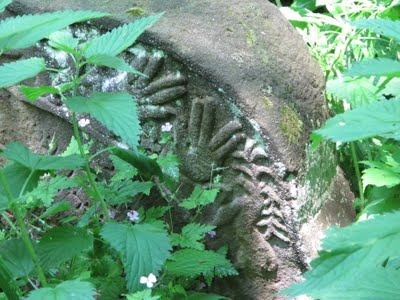 Photo (c) Ruth Ellen Gruber
Photo (c) Ruth Ellen GruberI can't put it any better than a post I have linked to before -- a description of the Lesko cemetery on the riowang.blogspot.com site.
Published on June 15, 2011 05:10
June 14, 2011
Poland -- The Chassidic Route
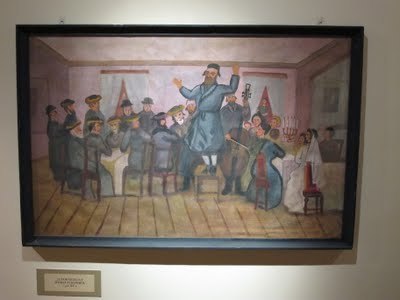 Painting in the Judaica section of a sacred art exhibit in the open-air folk architecture museum in Sanok. photo (c) Ruth Ellen Gruber
Painting in the Judaica section of a sacred art exhibit in the open-air folk architecture museum in Sanok. photo (c) Ruth Ellen GruberBy Ruth Ellen Gruber
While in the far southeast corner of Poland earlier this month, I visited a few of the Jewish heritage sites on the "Chassidic Route" itinerary in eastern and southeastern Poland promoted by the Foundation for the Preservation of Jewish Hertitage in Poland (FODZ).
The Chassidic Route itinerary includes :
Published on June 14, 2011 15:03
June 13, 2011
Poland -- New Jewish Guidebook to Poland Published in Warsaw
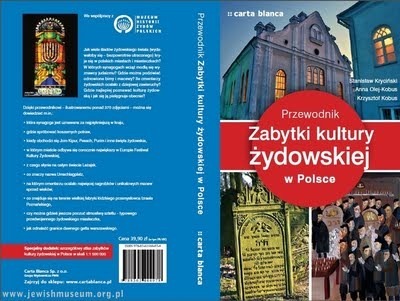
By Ruth Ellen Gruber
A new Jewish guidebook to Poland goes on sale this month, published under the auspices the Museum of the History of Polish Jewry, now under construction in Warsaw and due to open in 2013. Here's what the Museum's Virtual Shtetl web portal has to say about the new guidebook (it's unclear if there is an English language edition yet, though I assume there will be one):
Zabytki kultury żydowskiej w Polsce (Monuments of Jewish Cultural Heritage in Poland) is a new, richly illustrated, guide to places that merit a visit and closer acquaintance. The Museum of the History of Polish Jews has assumed patronage over the guidebook, which will go on sale on June 19th.
Books published under the Museum's patronage have included popular-science works, albums and historical atlases. Today they are joined by a guidebook to Jewish historical monuments in Poland that survived World War II, published by Carta Blanca. It encourages readers to visit these sites during holidays.
MHPJ involvement in the guidebook's creation was enormous, mainly because the source material for the work was provided by the Museum's Virtual Shtetl community portal, which contains information on nearly 2000 localities within Poland's current and pre-war borders. Our heartfelt thanks also go to Magda Propokopowicz, who was in charge of editing that material.
The guidebook is divided into 11 regions and describes 170 locations (both places that are well-known such as Łódź or Kraków, as well as small towns and villages) which were once inhabited by Jewish communities – at times very large. The Jewish contribution to each locality is shown against the background of its history. The text portrays eminent local personalities, describes the history of local synagogues, cemeteries and other Jewish communal facilities, and is intertwined with Jewish jokes, curiosities and anecdotes. The guidebook is beautifully illustrated with as many as 370 photographs by respected travel photographers Anna Olej-Kobus and Krzysztof Kobus. This fascinating tale of Jewish places in Poland is supplemented by a dictionary of basic Jewish terms, atlas of historical monuments rendered in a scale of 1:1 500 000 and an introduction to Judaic history, customs and traditions.
Since the goal of the guidebook is to popularise Jewish sites in Poland, it answers questions such as:
- Which Polish synagogue is considered the most beautiful? - Where can one taste genuine kosher food? - When are Yom Kippur, Pesach, Purim and other Jewish holidays celebrated? - Which Polish city hosts every year the largest Jewish culture festival in Europe? - What is the town of Leżajsk world famous for? - What does the name Umschlagplatz mean? - Which Jewish cemetery features the largest number of tombstones and unique matzevot that survived the Nazi occupation? - What can be found today in Łódź on the grounds of the huge factory that was once owned by the industrialist Izrael Poznański? - Is it still possible to feel the atmosphere of a shtetl anywhere in Poland? - How to find the boundaries of the former Warsaw ghetto?
I have to say, that most of these questions are answered in my Jewish Heritage Travel: A Guide to Eastern Europe, which takes in 14 countries, not just Poland.
This new guidebook is by no means the first Jewish guidebook to Poland. There have been regional and local guides published since the 1980s, and a national guidebook came out around 1991.
In 2010, Pascal -- a leading Polish publisher of travel books, came out with an updated version of Adam Dylewski's 2002 English-language guidebook, which had the unfortunate title "Where the Tailor Was a Poet...Polish Jews and Their Culture" The new edition --which I saw on sale in Krakow this month -- is simply called "Polish Jews and Their Culture, an Illustrated Guide."
Published on June 13, 2011 02:11
June 12, 2011
Krakow -- Upscale Kosher Restaurant
By Ruth Ellen Gruber
Krakow now has an upscale kosher restaurant. Called the Olive Tree, it is located on Kupa street in the heart of the Jewish district, Kazimierz, and has kosher certification from the Manchester-based Badatz Igud Rabbonim.
I didn't try it on the one night I was in Krakow this month, but I peeked in, and the ambience is certainly nice; sleek and smooth, with low lights and casual-elegant decor. No kitsch or nostalgia in view!
The menus for breakfast, lunch and dinner are on the web site.
Krakow now has an upscale kosher restaurant. Called the Olive Tree, it is located on Kupa street in the heart of the Jewish district, Kazimierz, and has kosher certification from the Manchester-based Badatz Igud Rabbonim.
I didn't try it on the one night I was in Krakow this month, but I peeked in, and the ambience is certainly nice; sleek and smooth, with low lights and casual-elegant decor. No kitsch or nostalgia in view!
The menus for breakfast, lunch and dinner are on the web site.
Published on June 12, 2011 03:16
June 10, 2011
Poland -- Krakow's Night of the Living Synagogues
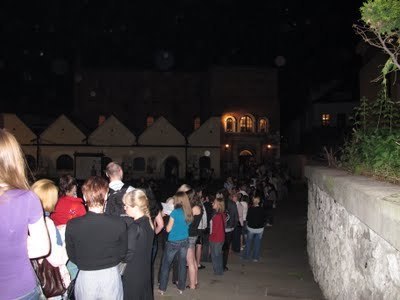 Long line waiting to get in to the Old Synagogue, around 1 a.m. Photo (c) Ruth Ellen Gruber
Long line waiting to get in to the Old Synagogue, around 1 a.m. Photo (c) Ruth Ellen GruberBy Ruth Ellen Gruber
The "Night of the Synagogues" in Krakow last weekend -- June 4 -- was the last stop in my Hungary-Poland trip; I had spent the week in and around Sanok, in the far southeastern tip of the country, and I was torn between going on to Krakow for the synagogue night or returning to Budapest.
Krakow won out -- how could I resist? I have been watching the development of the city's Jewish quarter, Kazimierz, for more than 20 years -- from an empty slum to one of the liveliest spots in the city. I have watched (and written extensively about) the restoration of its synagogue buildings, and the Jewish and "virtually Jewish" tourism, retail, entertainment and educational infrastructure: cafes, restaurants, museums, culture centers, etc etc etc....
On the Night of the Synagogues, all seven of the historic synagogues in Kazimierz were open to the public from 10:30 p.m. until 2 a.m. And each one hosted cultural or educational programming. The event was sponsored by the Krakow Jewish Community Center, the Joint Distribution Committee and the Jewish communal organization.
The night was a resounding success, and I feel privileged to have been there. More than 5000 people (maybe many more, as organizers had a hard time counting) made the rounds and visited the synagogues -- there were huge bottlenecks at doorways and a constant flow of people.
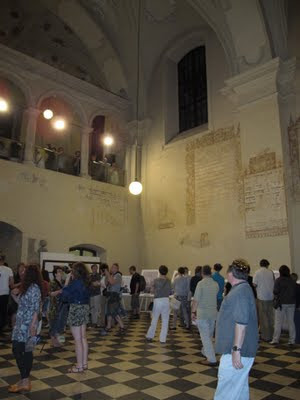 Crowds inside the Izaak synagogue, where there was an exhibition on Israel and an Israeli dance workshop. Photo (c) Ruth Ellen Gruber
Crowds inside the Izaak synagogue, where there was an exhibition on Israel and an Israeli dance workshop. Photo (c) Ruth Ellen GruberThe evening kicked off with an open-air Havadalah ceremony in the JCC courtyard, led by Krakow Rabbi Boas Pash, JCC director Jonathan Ornstein and the JDC's Karina Sokolowska from the JCC annex roof.
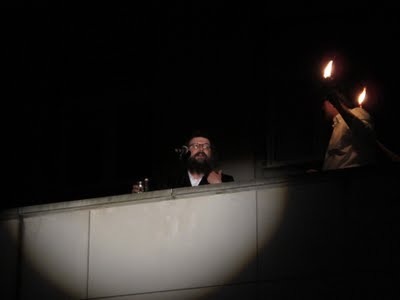 Photo (c) Ruth Ellen Gruber
Photo (c) Ruth Ellen Gruber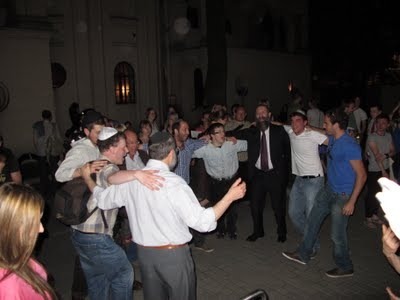 Photo (c) Ruth Ellen Gruber
Photo (c) Ruth Ellen GruberThen, the crowds dispersed into the district -- a district that has many crowded bars, restaurants and cafes that remain open into the wee hours. I managed to get to all seven of the synagogues -- but I forgot that the Galicia Jewish Museum was also open, so I didn't make it there.
There are only a few hundred Jews living in Krakow, and the vast majority of synagogue-visitors were non-Jewish local Poles.
There was a long line to get into the gothic Old Synagogue, which has been a Jewish museum for the past half century. Here, a DJ playing an eclectic mix of Jewishy rock and other music was ensconced under the wrought iron grill of the Bimah while visitors looked at an exhibit on Krakow synagogues and other Jewish buildings that no longer serve their original function.
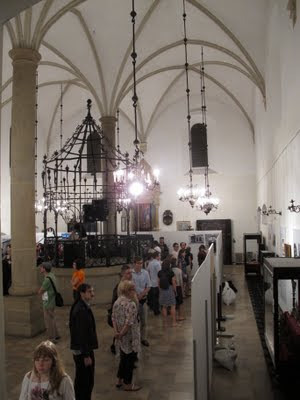 Photo (c) Ruth Ellen Gruber
Photo (c) Ruth Ellen GruberThere were panel discussions in the Kupa synagogue on the role of women in Judaism and young people in today's Jewish experience in Poland -- every seat in the audience was full. The Popper Synagogue, now a culture center, hosted an arts workshop. And an Israeli rock band gave a (loud) concert in the Tempel -- the ornate 19th century synagogue that was restored in the 1990s thanks in part to the World Monuments Fund.
The 16th century Remuh synagogue -- still the main Jewish place of worship in Krakow -- was also more or less standing room only. Here, Rabbi Pash gave a series of talks on the ABC's of Judaism. People had to sign up, as the space was limitied -- and I was told that ten times the number expected tried to attend. The overflow stood in the women's section, which originally was to have been closed.
 Rabbi Boas Pash speaks to crowd in Remuh synagogue. Photo (c) Ruth Ellen Gruber
Rabbi Boas Pash speaks to crowd in Remuh synagogue. Photo (c) Ruth Ellen GruberThere was also an exhibit in the High Synagogue -- and a multi-media presentation projected on the ceiling. It focused on contemporary Jewish life in Poland, highlighting the reborn and reemerging community, and particularly the young people who in Krakow have gravitated to the JCC and its activities.
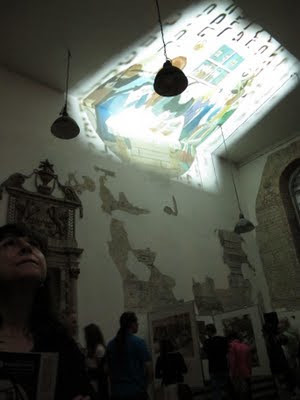 Multi-media presentation in High Synagogue. Photo (c) Ruth Ellen Gruber
Multi-media presentation in High Synagogue. Photo (c) Ruth Ellen GruberAll in all it was a terrific event -- and very gratifying to someone like me who remembers the bad old days! Mazel tov to those who planned it and took part!
Published on June 10, 2011 14:51
June 9, 2011
Hungary to Poland trip -- Lutowiska!
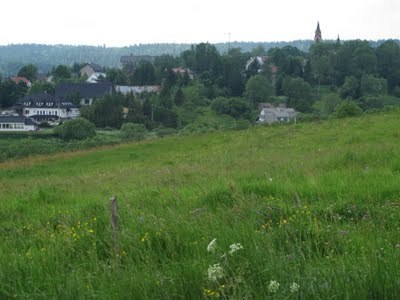 View of Lutowiska from Jewish cemetery. Photo (c) Ruth Ellen GruberBy Ruth Ellen Gruber
View of Lutowiska from Jewish cemetery. Photo (c) Ruth Ellen GruberBy Ruth Ellen GruberOne of my aims in the southeastern corner of Poland was to visit some the Jewish heritage sites for the first time -- as well as revisit some of that I had been to previously to update my information on their status and condition.
One of these first-time places was the hamlet of Lutowiska -- way down in the triangular southeastern tip of the country that pokes between Ukraine and Slovakia, very close to the Ukrainian border. It was once a major trading center, with a large Jewish population. According to a Yizkor book entry on Lutowiska, Jews were the majority population from the late 19th century.
Here's information from the town web site:
The name Lutowiska comes from the Russian word „letowyshche" designating a place where cattle and sheep were grazed in summer. The village was set up in the 16th century according o the Wallachian law in estates that then belonged to the Stadnicki family. The village was first referred to in 1580. The village was located on the intersection of busy trade routes from Sanok to the Tucholska Pass and further to Transylvania and from Przemyśl through the Beskid Mountains or Użock Pass to Użhorod. There was also a local route to the East through Turka to Drohobycz. Such a place encouraged the location of a town. Thanks to the efforts of Ludwik Urbański Lutowiska was granted a charter at the beginningof the 18th century. In 1742 King August III granted the town a privilege to hold ten big fairs a year (by comparison Sanok and Lesko only held two big fairs a year). In the 19th century the big fairs in Lutowiska were famous throughout Europe. People chiefly traded in oxen that were grazed on high-elevation meadows (poloninas). They were grey, long-horned cattle called Hungarian, willingly bought even by merchants from Western Europe. During thebig fair the whole Lutowiska was packed with cattle, a few thousand animals were here at a time. Lutowiska's centra consisted then of two adjoining market places surrounded by wooden houses, which mainly belonged to Jews, a majority of the town's population. Lutowiska lost the status of town in 1919, though it remained the region's significant trade and administrative centre until the Second World War. The census of 1921 discovered 261 houses inhabited by 2125 people. In 1939 the settlement already had about 3500 inhabitants. In June 1942 Gestapo officers from Ustrzyki Dolne shot ca. 650 local Jews. They also burnt the synagogue and Jewish houses, practically all the wooden buildings in Lutowiska. Between 1945 and 1951 Lutowiska was within the Soviet borders, the name was changed to Shevchenko. At the end of 1951 a mere 28 families lived there. Resettlers from the Sokal and Hrubieszów regions mainly moved to the deserted houses. The village only reverted to its original name after a few years. In 1951 Lutowiska became home to communal authorities.
I had been told that there was a Jewish cemetery here, but that it was outside the village; I would have to ask, I was told, but people would know.
In fact, there is a beautiful, and beautifully maintained, Jewish cemetery here, as well as the ruins of the synagogue -- and I was delighted to find that local authorities have included both into a touristic/educational route in and around the town that focuses on the three cultures that before WW2 coexisted here -- Jews, Poles and Ukrainians.
 Sign of Three cultures route outside entry to Jewish cemetery. Photo (c) Ruth Ellen Gruber The cemetery is on a hill behind the town's big school, immersed in lovely rolling landscape -- I found it by asking at the local tourism office, where an English-speaking young man gave me explicit directions as well as a brochure and map for the Three Cultures route. I walked there, following three back-packing girls who also headed that way to visit the site.
Sign of Three cultures route outside entry to Jewish cemetery. Photo (c) Ruth Ellen Gruber The cemetery is on a hill behind the town's big school, immersed in lovely rolling landscape -- I found it by asking at the local tourism office, where an English-speaking young man gave me explicit directions as well as a brochure and map for the Three Cultures route. I walked there, following three back-packing girls who also headed that way to visit the site.The cemetery is enclosed by a rustic fence, and the weeds and grass are cut. There are some dozens of gravestones, some with fairly elaborate carving; tilted, some eroded -- I was able to document a lot of women's tombstones, for my (Candle)sticks on Stones project, showing a variety of carved versions of candlesticks. Some of the carvings were very reminiscent of the carving style in Busk and other places across the border in what is today Ukraine.
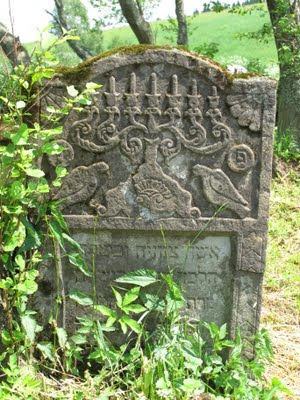 Photo (c) Ruth Ellen Gruber
Photo (c) Ruth Ellen Gruber
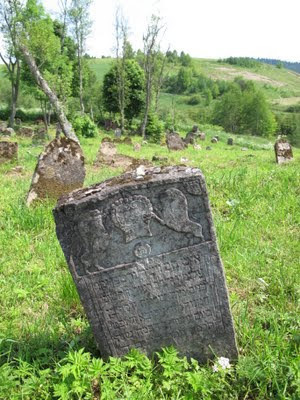 The carving on this stone reminds me of that across today's border in Ukraine. Photo (c) Ruth Ellen Gruber
The carving on this stone reminds me of that across today's border in Ukraine. Photo (c) Ruth Ellen Gruber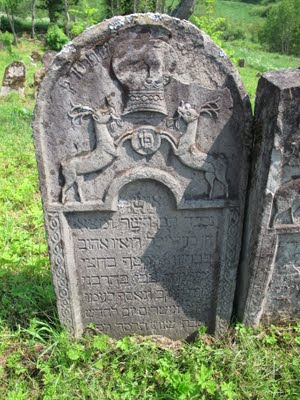 Photo (c) Ruth Ellen Gruber Other sites on the Three Cultures itinerary include the Greek-Catholic cemetery, with a replica of the wooden church that no longer stands here:
Photo (c) Ruth Ellen Gruber Other sites on the Three Cultures itinerary include the Greek-Catholic cemetery, with a replica of the wooden church that no longer stands here: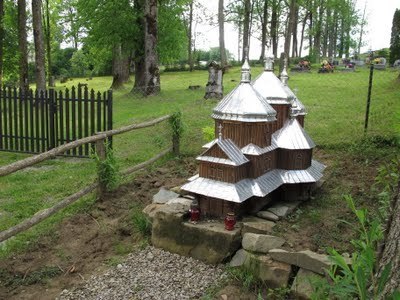 Replica of the Greek-Catholic church Photo (c) Ruth Ellen Gruber
Replica of the Greek-Catholic church Photo (c) Ruth Ellen Gruber
Published on June 09, 2011 11:16
June 8, 2011
Hungary to Poland trip Part I -- a Jewish cemetery uncovered....
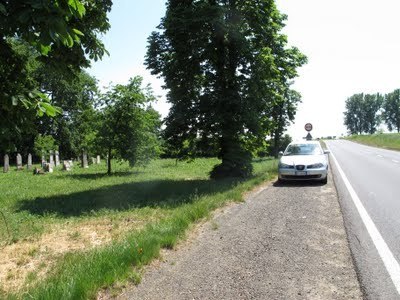 Revealed on the road side. Photo (c) Ruth Ellen Gruber By Ruth Ellen Gruber
Revealed on the road side. Photo (c) Ruth Ellen Gruber By Ruth Ellen GruberI'm beginning to post material from my recent road trip to Hungary and Poland; it was somehow difficult to get things online when traveling....
My itinerary took me from Budapest to Sanok and other towns in the far southeast corner of Poland, and then to Krakow. Most of the route through Hungary is four-lane motorway, but from Miskolc north to the border with Slovakia it's still a two-lane highway.
The first time I recall driving this way was in 1992, when I was researching my book "Upon the Doorposts of Thy House: Jewish Life in East-Central Europe, Yesterday and Today." One of the chapters of that book is a long essay, "Wine Merchants and Wonder Rabbis" about the links that connected northern Hungary and southern Poland -- wine going north, Hassidism going south.
At that time, the only person I encountered who remembered the existence of the Jewish cemetery of Méra, a village in northern Hungary in the road to the Slovak border, was a malodorous old drunk, who got in the car and guided me there. I found the broken frame of a gate and a few eroded tombstones imbedded in a thick wall of brush just off the side of the main road.
The last time I had driven that way, a few years ago, I hadn't been able even to make out where the cemetery was, it was so overgrown. There seemed to be nothing. I feared it was totally lost -- and with it, the memory of the Jews who had lived there.
So this time, I was quite surprised to find that the cemetery had been cleared of brush, bushes, under- and overgrowth, with the stones fully exposed. In fact, I was astonished! Even the grass/weeds had been freshly cut! (I'm not sure, though, who has carried out the work or when it was done.)
 Photo (c) Ruth Ellen Gruber
Photo (c) Ruth Ellen GruberWhat was revealed, however, was the story of death and vandalism as well as remembered life... some of the stones had been broken or smashed...., but the fragments had been gathered and stood together.
 Photo (c) Ruth Ellen Gruber
Photo (c) Ruth Ellen GruberBut...regardless -- there they were! Clean, cleared, exposed, not submerged any more out of sight out of mind; revealed for all to see!
Published on June 08, 2011 13:24



